Input interpretation

methanesulfonic acid
Chemical names and formulas
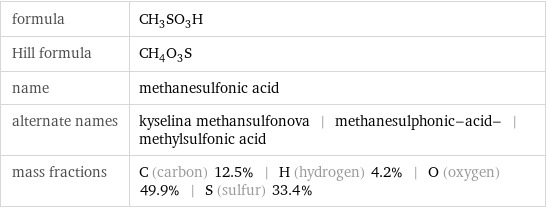
formula | CH_3SO_3H Hill formula | CH_4O_3S name | methanesulfonic acid alternate names | kyselina methansulfonova | methanesulphonic-acid- | methylsulfonic acid mass fractions | C (carbon) 12.5% | H (hydrogen) 4.2% | O (oxygen) 49.9% | S (sulfur) 33.4%
Lewis structure
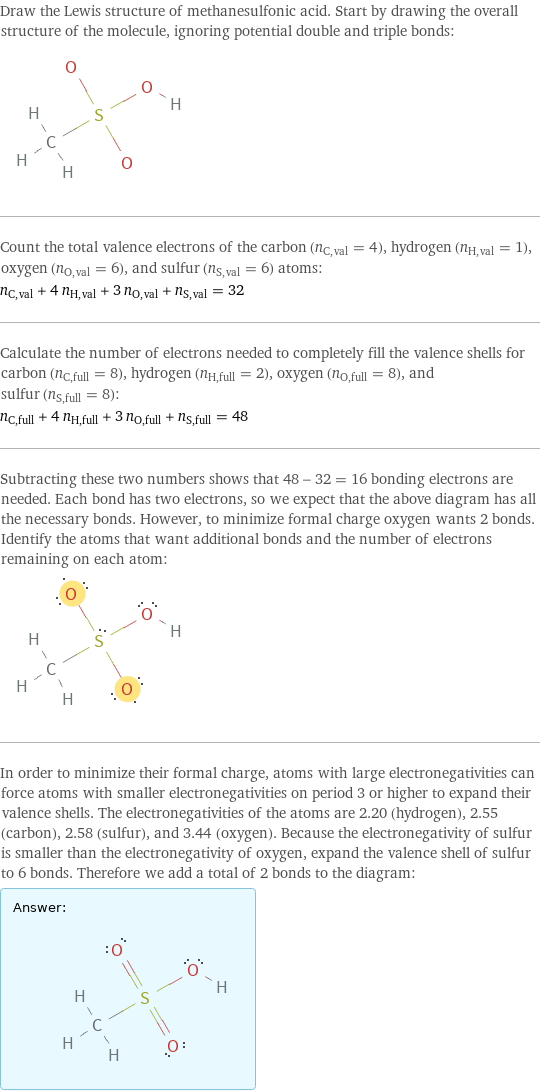
Draw the Lewis structure of methanesulfonic acid. Start by drawing the overall structure of the molecule, ignoring potential double and triple bonds: Count the total valence electrons of the carbon (n_C, val = 4), hydrogen (n_H, val = 1), oxygen (n_O, val = 6), and sulfur (n_S, val = 6) atoms: n_C, val + 4 n_H, val + 3 n_O, val + n_S, val = 32 Calculate the number of electrons needed to completely fill the valence shells for carbon (n_C, full = 8), hydrogen (n_H, full = 2), oxygen (n_O, full = 8), and sulfur (n_S, full = 8): n_C, full + 4 n_H, full + 3 n_O, full + n_S, full = 48 Subtracting these two numbers shows that 48 - 32 = 16 bonding electrons are needed. Each bond has two electrons, so we expect that the above diagram has all the necessary bonds. However, to minimize formal charge oxygen wants 2 bonds. Identify the atoms that want additional bonds and the number of electrons remaining on each atom: In order to minimize their formal charge, atoms with large electronegativities can force atoms with smaller electronegativities on period 3 or higher to expand their valence shells. The electronegativities of the atoms are 2.20 (hydrogen), 2.55 (carbon), 2.58 (sulfur), and 3.44 (oxygen). Because the electronegativity of sulfur is smaller than the electronegativity of oxygen, expand the valence shell of sulfur to 6 bonds. Therefore we add a total of 2 bonds to the diagram: Answer: | |
3D structure
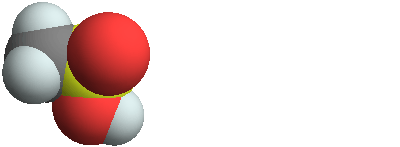
3D structure
Basic properties
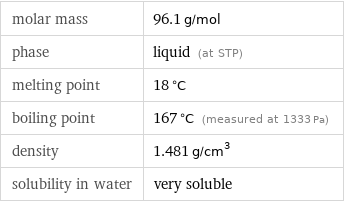
molar mass | 96.1 g/mol phase | liquid (at STP) melting point | 18 °C boiling point | 167 °C (measured at 1333 Pa) density | 1.481 g/cm^3 solubility in water | very soluble
Units

Liquid properties (at STP)
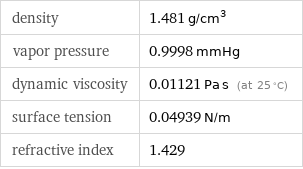
density | 1.481 g/cm^3 vapor pressure | 0.9998 mmHg dynamic viscosity | 0.01121 Pa s (at 25 °C) surface tension | 0.04939 N/m refractive index | 1.429
Units

Chemical identifiers

CAS number | 75-75-2 Beilstein number | 1446024 PubChem CID number | 6395 SMILES identifier | CS(=O)(=O)O InChI identifier | InChI=1/CH4O3S/c1-5(2, 3)4/h1H3, (H, 2, 3, 4)/f/h2H RTECS number | PB1140000 MDL number | MFCD00007518
NFPA label

NFPA label
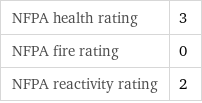
NFPA health rating | 3 NFPA fire rating | 0 NFPA reactivity rating | 2
Safety properties

flash point | 110 °C autoignition point | 500 °C

DOT hazard class | 8 DOT numbers | 2586
Toxicity properties

RTECS classes | agricultural chemical and pesticide | mutagen